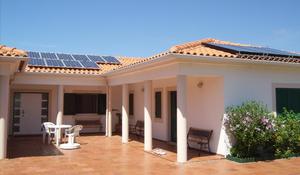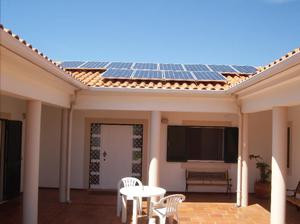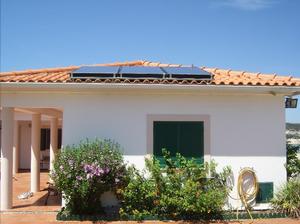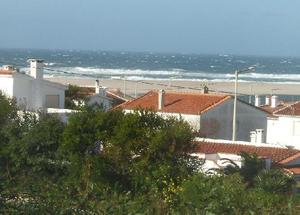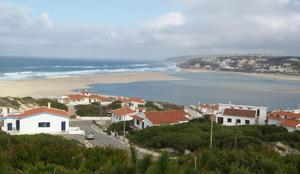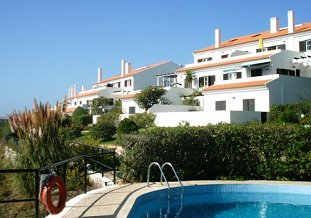Solar Energy - lowers cost of luxury for Silver Coast property
Eco-House with solar energy and beach views on the Obidos Lagoon
An example of environmentally friendly home heating. Plus a case study for how the recent Portuguese legislation in support of solar energy has lowered the cost of luxury living in this four bedroom property on the Bom Sucesso beach. Image right shows front view of the courtyard and solar panels June 2009 - click any property images to enlarge
When the house was purchased by the current owner in 2005 it was neither warm nor energy efficient. The water heating was by gas. The cooking was by gas and electric, and the space heating in the winter was by solid fuel fireplaces and a wood burning stove. Lovely as a summer home but the heating was not ideal for winter use. Image below taken Christmas 2008 - Beach view from the living room window.
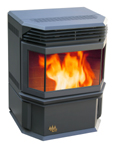
Initially the owner installed the pellet burners for space heating followed by the solar water heating, which instantly warmed the house and lowered the cost of hot water to an insignificant amount for the brief periods that the sun does not provide enough. Even those small costs are now covered by the photo-voltaic energy production.

The owner also contracted at the same time to install the photo-voltaic panels which, at the favourable rate paid to the owner for solar energy, will now produce more than enough revenue to pay all the utility bills, (gas, water and electricity) for the household and cover all (or most) of the cost of winter space heating.
As the implementation of legislation to allow selling the electricity to the national grid was delayed until 2008, the approval for the grid connection of the photo-voltaic system only took place in 2009 and the system was finally connected to the grid on 18th June 2009.
The photovoltaic panels were instantly providing and selling more than 14 kwh to the grid daily in June, although that figure is estimated to reduce substantially in the winter months. Nevertheless it is conservatively estimated that an average of 9kwh per day should be achieved by the system over a full year based on the national weather data.
The hot water system (solar thermic) provides the owner with all the hot water needed in both winter and summer.
For occasional short periods in the winter months, if inclement weather lasts for more than a couple of days, the hot water tank stores 390 litres of hot water which is sufficient to tide the owner over any cooler periods. Reversion to electricity or gas for water heating in such periods can be automatic, but the periods are so short that the owner opted to control this cost further by manually switching over to gas only if and when necessary.
Clean Pure and Plentiful Water.
Water is supplied to the house by both mains and bore hole. The owner has not needed to turn on the mains for more than a few hours during pump maintenance since purchasing the house. Water from the bore hole not only tastes nicer, and is filtered by activated charcoal for the house, but it is substantially cheaper than mains water.
The only water cost is the electricity to raise the water from below the ground, and the tiny standing charge on the idle mains water system. This means that water consumption for both garden and pool would not anyway be as costly as other properties in the region, but now in 2009 this cost is totally covered by the photo-voltaic energy production.
Pool heating.
The solar thermic system is pre-equipped with an automatic system to send the excess hot water energy to the swimming pool that the owner is planning on building. The solar thermic system produces far too much heat in the period March to November so the swimming pool season will certainly be lengthened. The plan is to either cover the pool with a purpose built retractable unit, or make the pool an indoor one. Either way with the probable addition of a heat exchange system the pool will be usable and much warmer all year round.
For space heating the owner has already installed 3 modern Ecoforest pellet burning stoves which provide push button heating where it is needed using fuel pellets made from forestry waste products. This makes the space heating both environmentally friendly, easy to use, and very economical.

The owner opted for three separate pellet burning units, two Eco-Aire and one Vigo from Ecoforest, rather than one large central one with radiators as this gives much easier and greater flexibility over where and when heat is produced and how it is distributed.
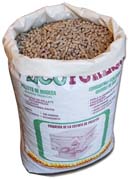
The log burning fireplaces have been retained in the property for character but as the heat from the pellet burners is more than enough the fireplaces are only ever used for cosmetic purposes. Typically a log or fir-cone fire is lit on special occasions like Christmas when a few flames in the hearth provide additional good cheer. The fir-cones are often collected from the roadsides in the empty pellet sacks while the owner is out walking which means that collecting the fuel for the fire also helps to provide good healthy exercise.
The cost of Energy Self Sufficiency.
In round figures the total capital cost of all the energy efficiency changes and additions detailed above was less than 30 thousand euros. As the revenue from the photo-voltaic panels should exceed 2 thousand euros per year, with space heating costs being around 700 for the pellets, and all the other utilities now reduced to around 1200, it is probable that the house will not only be energy self sufficient, but will show the owner a small and rising bonus.
With energy costs likely to rise in the longer term, and the amount paid by the grid contracted and legislated to rise proportionately, the capital investment should continue to be more than worthwhile. Image above taken Christmas 2008 - view on wintry day of choppy seas taken from living room window. Below the lagoon taken on a fine day over the same Christmas 2008 holiday period - click the images to enlarge.
All the above and a beach view can be yours if you wish. Just click on the link below to contact the owner for more details and see more of this:-
